Friday, 23 November 2012
In Design First Attempt
This is my first attempt at creating a double page spread; it was also my first time using the In-Design software. Although at this point I had only used very simple and basic tools on the program I did like using it and I found it easier to use than Photoshop. For my first use of the program I created a masthead, added the main image along with two other images, added the article and used dropcap. To create the masthead I chose the rectangle tool and used it to create the shape to type my headline; when I had drawn the shape I then clicked on the type tool and wrote my headline. Once I had done this I clicked on window then colour to change the colour of the text and to add the stroke effect which changes the outline of the letters, I increased the weight and changed the colour. To add the images I chose the frame tool and created the shape I wanted; before this I had to save the images into a folder as you should never copy and paste using this program. To insert the picture I had to click file then place then browse to find the image I wanted and add it. When you add pictures on this program they are likely to be too large for the shape you choose; to alter this you need to right click on the picture then click fitting then fit proportionally. In this case I just needed to get used to the program so to add the article I used another piece of work and copied it; before this I used the rectangle tool to add the three columns. When I had done this I copied the text into the first column; when there is too much text for that particular column a red square should appear at the bottom of the text, you use this to click on it and then drag the rest of the text to another column. To make the dropcap I highlighted the first paragraph and went to the properties tool bar and clicked on the tool with a small A on to increased the number. The black arrow on the program is used to adjust the frame size and rectangle size, whereas the white arrow is used to adjust the picture size.
Thursday, 15 November 2012
1st and 2nd Person Narratives - Alcohol - Related to Unit 3
One night I was on the streets with my friends for what was initially thought to be a fun night of drinking, yet it turned out to be a near disaster. One of my friends had too much to drink and collapsed. I and my friends all panicked not knowing what to do. He was admitted to hospital and that night he almost died. One careless night with my friends nearly turned into the worst night of my life.
The effect of this opening paragraph is that is gives it an emotional feel, someone’s actual experience and opens the eyes of the reader to the small anecdote which could easily happen to them if they are not careful. It is short which increases the read-speed and adds more energy. The shock/ horror introduction captures the reader’s attention; it draws them in and makes them want to continue reading.
You should be asking yourself these questions: are you an underage drinker? Are getting drunk to often? Do you not think about what you’re doing to yourself? Can you answer me these questions: are you concerned about the amount of alcohol consumption you have and where you future lies if you continue? Are you concerned about your personal well-being, your short-term health and long-term health, if you’re not then why not? You need to think to yourselves; could this affect my family? But most of all you need to ask yourselves; why do I drink?
The effect of this opening paragraph is that it hooks the reader; they find that they want to read on because the questions are making them want the answers. It has a medium speed; I think this makes the reader become lost in the paragraph and find themselves just continuing to read which means that the paragraph has done its job because it is meant to make the reader read on.
Friday, 9 November 2012
Healing tool - Photoshop
I have used the healing brush tool in Photoshop to clear the person's face. It is simple and easy to use: first paste a photograph into Photoshop, then alter the size of the tool next to where you are going to use it, it needs to be the same size as what you are clearing. Once you have chosen the size you need to hold down the Alt key on your keyboard and click your mouse next to where you are going to clear, and then click over the area you are clearing. You will need to repeat this process each time you want to clear something.
Vampire Photograph - Photoshop
I have used the burn tool around the eyes to darken their edges which makes them look scarier. Next I used the sponge tool all over the face to take the colour out; I set the tool to de-saturate. This makes the person look more like a vampire. After this I used the magnetic lasso tool; this tool allowed me to alter the teeth and to create the fangs. To use this tool effectively and accurately firstly you should zoom in to the teeth then click on the tool, then click around the tooth you choose, it should come up with a dotted shape around the tooth. When this appears you need to go to edit, transform and warp then alter the shape how you want. When you have finished altering the tooth click enter and control D, you should do this for two teeth. Lastly you need to create a new layer and choose the brush tool and the colour red; make sure you are on the new layer and colour the eyes red. Once you have coloured them in choose the darken effect from the drop-down menu and alter the opacity. Then you have finished.
Friday, 26 October 2012
Photoshop - Curves and Levels Photograph
CD Cover - Photoshop
I have created my own CD cover in Photoshop. First I added the name of the
song - Old School - and the name of the group - Nature's Hero's. I chose a font
that was already on Photoshop rather than downloading my own, I chose to do
this because I think it suits the name of the group and the name of the song. I
made it green simply because the group is called 'Nature's' Hero's and the
colour green is associated with nature. I added the stroke effect and drop shadow
effect to the text; this makes it stand out more and adds energy to it because
if these effects were not added the text would just look plain and boring.
For the background I used the gradient tool in every corner and added 3 different brushes that I downloaded from www.brusheazy.com. To download these brushes I searched the website until I found one that I wanted to use then I clicked on it, then clicked download, then I clicked on the file in the folder and chose to extract it and then I saved it in my brushes folder that I created. After this process I had to load it on Photoshop so I could use it; to do this I had to click on the Brush tool on Photoshop, then at the top of the program there was a drop down menu for the brush tool, I clicked this then on the drop down menu there was another drop down menu which I then clicked on, from this menu I clicked on load brushes and chose the brushes I had downloaded and from this I could use them on Photoshop. Once I had all the brushes I downloaded in Photoshop I freely used them trying to create something I found appealing; I think the cover I have created looks like tie-dye which I think looks good.
For the background I used the gradient tool in every corner and added 3 different brushes that I downloaded from www.brusheazy.com. To download these brushes I searched the website until I found one that I wanted to use then I clicked on it, then clicked download, then I clicked on the file in the folder and chose to extract it and then I saved it in my brushes folder that I created. After this process I had to load it on Photoshop so I could use it; to do this I had to click on the Brush tool on Photoshop, then at the top of the program there was a drop down menu for the brush tool, I clicked this then on the drop down menu there was another drop down menu which I then clicked on, from this menu I clicked on load brushes and chose the brushes I had downloaded and from this I could use them on Photoshop. Once I had all the brushes I downloaded in Photoshop I freely used them trying to create something I found appealing; I think the cover I have created looks like tie-dye which I think looks good.
Friday, 19 October 2012
Photoshop Basics
This photograph has been vignetted this is where the outer edges are darkened to make the viewers eyes drawn to the centre. I have also used the dodge and burn tools; the dodge tool lightens the area that you click on whereas the burn tool darkens the area you click on.
To make the photograph vignetted on Photoshop you have to first go to the Elliptical Marquee tool and cover most of the image, but before this you must change the feathering to between 60 and 90; this will make it look more transitioned rather than having a clear line where the circle has been drawn. Next you need to go to select > inverse, then image > adjustments > brightness/ contrast; from here to can alter the brightness and contrast to what you want.
This photograph has only been slightly changed; I have used auto-colour, this just automatically makes Photoshop adjust the colour in the photograph. The colour has been slightly darkened and been made slightly 'fuller'.
To use auto-colour you need to go to image > auto-colour. There is also different things you can use after clicking on image such as auto-contrast and auto-tone.
This photograph has simply been de-saturated, this is where all the colour is taken out of the photograph and it becomes black and white. I also adjusted the brightness and contrast to make parts darker and parts lighter to shows a clearer difference.
To de-saturate a photograph on Photoshop you need to go to image > adjustments > de-saturate. To alter the brightness and contrast you need to go to image > adjustments > brightness/ contrast.
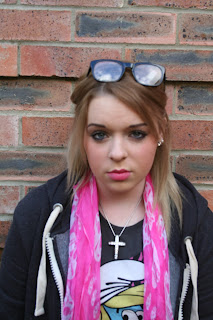
To make the photograph vignetted on Photoshop you have to first go to the Elliptical Marquee tool and cover most of the image, but before this you must change the feathering to between 60 and 90; this will make it look more transitioned rather than having a clear line where the circle has been drawn. Next you need to go to select > inverse, then image > adjustments > brightness/ contrast; from here to can alter the brightness and contrast to what you want.
This photograph has only been slightly changed; I have used auto-colour, this just automatically makes Photoshop adjust the colour in the photograph. The colour has been slightly darkened and been made slightly 'fuller'.
To use auto-colour you need to go to image > auto-colour. There is also different things you can use after clicking on image such as auto-contrast and auto-tone.
This photograph has simply been de-saturated, this is where all the colour is taken out of the photograph and it becomes black and white. I also adjusted the brightness and contrast to make parts darker and parts lighter to shows a clearer difference.
To de-saturate a photograph on Photoshop you need to go to image > adjustments > de-saturate. To alter the brightness and contrast you need to go to image > adjustments > brightness/ contrast.

Monday, 15 October 2012
Shutter Speed Photographs and Evaluation
Shutter speeds help determine the type of photograph the photographer
takes; it is simply the amount of light that is let in the camera when the
shutter is open that meets the sensor for a certain amount of time.
A fast shutter speed would be used for photographing fast
moving objects such as cars, water or people running. This is because the fast
shutter speed allows the camera to capture the sharpest photograph. There are
other uses for fast shutter speeds; for example if the photographer is panning
the camera with the subject in it, the photograph can be made to make the
subject sharp but have the background blurred. Sometimes motion blur can
improve the photograph; it may make the photograph look like it has more
movement and energy. People will use a fast shutter speed because it makes the
photograph look like its subject is frozen and it is at its sharpest, also
there will be no camera shaking: it will look completely still. A slow shutter
speed would be used to capture something that may just quickly occur like a
lightning bolt, or as I used a torch, the camera is able to capture these types
of photographs because the shutter allows the light in for longer so the camera
will capture it all. A slow shutter speed similarly to a fast shutter speed can also lead to superb photographs. People will use a slow shutter speed because it will allow
them to create a photograph that is ‘in the moment’ like a lightning bolt, you wouldn't be able to capture that by using a fast shutter speed. Photographers
have to be careful when they are taking their photographs with a slow shutter
speed; they will most likely have to use a tripod, this will stop any concerns
over the camera shaking and will make the best photograph rather than the
camera being hand-held.
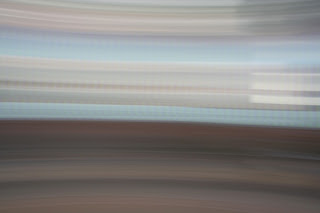
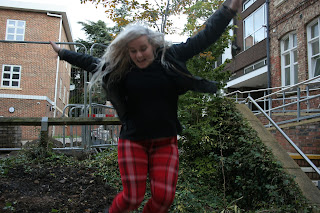
This photograph was also set to a fast shutter speed to make it in focus and sharp rather than blurred due to the fast movement of the subject. It is sharp; it has good lighting so I think the quality is good, with the exception of the framing. The framing is poor and lets this photograph down because one hand is cut off along with the bottom of both legs; to stop this problem happening in the future I will check them more carefully as soon as I take them and if I need to re-take them I will, I will also take a lot more of the same shot so I have more to choose from and stand further away to allow everything in the frame.
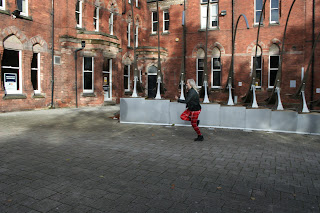
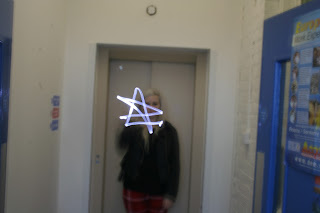
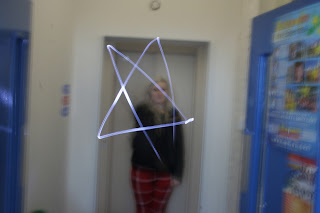
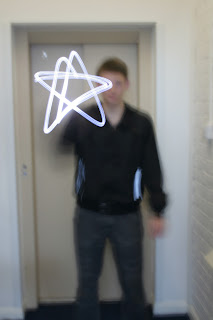
My overall targets are to make sure that the subject is fully in the frame if that is needed, to make sure the distance is correct to have everything in the frame but not be too far away, to remember to take lots of pictures just to make sure they will be correct and to check the lighting in each photograph and adjust the shutter speed if I need to and if I think it will improve the photograph.
Thursday, 4 October 2012
Composition Photographs Evaluation
This is a tilt shot, the camera is tilted upwards; I have learnt that this makes the subject look powerful, have authority over something. Yet this type of shot also can have bad effects such as if it was a close up shot, it wouldn't be appealing because the subjects nostrils may draw people's attention rather than what the photographs intentions were originally. This shot can sometimes be more about power than glamour. It is composed well because the subject is placed directly in the centre of the photograph therefore the viewer will be drawn there, and the subject looks like a powerful figure.
This is also a tilted shot but this time it is tilted down. I have learnt that this shot makes the subject become powerless, innocent and inferior. Sometimes this shot may be used to create sympathy or it could be used to make someone look small, this could mean that they are not as big and as smart as they think, or it could be a situation where the subject was on top of the world but then lost everything and became this person; if this was the case then this photograph would show their feelings which may be devastation, anguish or regret. It is composed well because the meaning that this photograph is supposed to have is clear; the subject does look small and powerless.
This shot has been taken off centre; the effect of this shot is that the subject may not be the most important part of the photograph and could be there to create effect or to give another meaning to something else in the photograph. It is composed well because the figure is in the left third of the photograph and may make some viewers think about why this has been done which will give photographs like this more meaning and recognition.
This photograph has been taken to make the subject's eye-line low; similar to the low-tilt shot. It usually means that the subject is powerless, innocent and inferior. Sometimes it could be because there is something else in the photograph which is more important; this could strengthen the meaning that the subject is powerless, innocent and inferior. This photograph is composed well because the subject looks lonely, depressed and inferior which is the meaning that this shot is supposed to have.
This is a close up shot; this type of shot is usually intended to show facial expressions or even to try to make people think about what the subject is thinking or feeling at a certain time. It is a shot type that people will see a lot; this is because it enables the photographs to connote or denote different things. It is composed well because the subject is looking straight into the camera lens; this will make viewers have different opinions of what she is thinking about or is feeling. It also is in sharp focus which allows the viewer to see specific facial expressions.
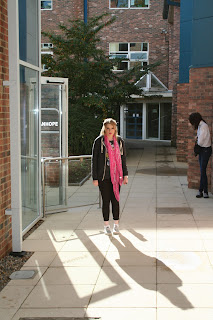
This photograph has been taken with a focal point, the focal point is usually taken in photographs with something leading to it which is usually a diagonal line; such as in the photograph the shadow is leading up to the focal point which is the person. The diagonal lines also add energy to the photograph because they are making the viewer look along or up or down the photograph waiting for something at the end. This photograph is not composed well; this is because there is more than one shadow. Therefore the energy is taken out of this photograph because the viewer will not be initially drawn to the subject's shadow and will have a slower reaction when they are first looking at the it.
All of the images are in focus and I used the focus ring to do this, this is mainly so that the photographs looked clear. I did not zoom in on any of the photographs because this may have made them become out of focus and I would have had to adjust the focus ring. Another reason for not zooming in would be because it may take the meaning of the photograph away. For example if I zoomed in on the first photograph and only showed the shoulders upwards and not the subject's body; it may have made them look less powerful and have less authority.
I think the strengths of my photographs are that they are all in focus and all of them apart from the last one are composed well. Another would be that the meaning that is supposed to be given in them is given apart from the last one.I think the only weakness of my photographs is that the last one is not composed well and as a result of this the purpose isn't clear and it takes the energy out of it.
This is also a tilted shot but this time it is tilted down. I have learnt that this shot makes the subject become powerless, innocent and inferior. Sometimes this shot may be used to create sympathy or it could be used to make someone look small, this could mean that they are not as big and as smart as they think, or it could be a situation where the subject was on top of the world but then lost everything and became this person; if this was the case then this photograph would show their feelings which may be devastation, anguish or regret. It is composed well because the meaning that this photograph is supposed to have is clear; the subject does look small and powerless.
This shot has been taken off centre; the effect of this shot is that the subject may not be the most important part of the photograph and could be there to create effect or to give another meaning to something else in the photograph. It is composed well because the figure is in the left third of the photograph and may make some viewers think about why this has been done which will give photographs like this more meaning and recognition.
This photograph has been taken to make the subject's eye-line low; similar to the low-tilt shot. It usually means that the subject is powerless, innocent and inferior. Sometimes it could be because there is something else in the photograph which is more important; this could strengthen the meaning that the subject is powerless, innocent and inferior. This photograph is composed well because the subject looks lonely, depressed and inferior which is the meaning that this shot is supposed to have.
This is a close up shot; this type of shot is usually intended to show facial expressions or even to try to make people think about what the subject is thinking or feeling at a certain time. It is a shot type that people will see a lot; this is because it enables the photographs to connote or denote different things. It is composed well because the subject is looking straight into the camera lens; this will make viewers have different opinions of what she is thinking about or is feeling. It also is in sharp focus which allows the viewer to see specific facial expressions.

This photograph has been taken with a focal point, the focal point is usually taken in photographs with something leading to it which is usually a diagonal line; such as in the photograph the shadow is leading up to the focal point which is the person. The diagonal lines also add energy to the photograph because they are making the viewer look along or up or down the photograph waiting for something at the end. This photograph is not composed well; this is because there is more than one shadow. Therefore the energy is taken out of this photograph because the viewer will not be initially drawn to the subject's shadow and will have a slower reaction when they are first looking at the it.
All of the images are in focus and I used the focus ring to do this, this is mainly so that the photographs looked clear. I did not zoom in on any of the photographs because this may have made them become out of focus and I would have had to adjust the focus ring. Another reason for not zooming in would be because it may take the meaning of the photograph away. For example if I zoomed in on the first photograph and only showed the shoulders upwards and not the subject's body; it may have made them look less powerful and have less authority.
I think the strengths of my photographs are that they are all in focus and all of them apart from the last one are composed well. Another would be that the meaning that is supposed to be given in them is given apart from the last one.I think the only weakness of my photographs is that the last one is not composed well and as a result of this the purpose isn't clear and it takes the energy out of it.
Friday, 28 September 2012
Magazine Cover
I used manual focus because it makes me
have more of an influence on the photograph. I learnt how to use the focus ring
and zoom ring on the camera, and where on the camera they are located. I also
learnt that the T-stance helps keep the camera steady when you are standing up
or crouching down, that it helps keep your own balance when you are taking
the photograph and it is a better body position when you are taking the
photograph. I learnt that most magazines take their pictures in portrait mode
and I learnt how to take the photograph in portrait mode. I took every picture
in portrait mode. I took most of my images in focus, the ones that weren't I didn't use. To make sure I take every picture in focus in the future I will take more
time adjusting the focus ring and take less picture that are better quality. I
learnt that lighting affects your photographs so you need to be aware of where
the sun is located and if it is affecting your photographs. Side-lit makes the
photographs lighter on one side than another, front-lit sometimes will create
shadows in the photographs and back-lit makes the front of the photograph
darker than the back. I use the rule of thirds; I took some photographs with
the eye-line too low so I crouched to make the eye-line where it is supposed to
be: the first line down from the top of the photograph. The background for my
photograph was easy to find because it was only a brick wall; I wanted this
background because it was supposed to look like the model was in jail behind
metal bars. My model was easy to handle and didn't cause any problems, he just
did what I asked of him to do in my photograph. My people skills were
good enough to be in control.
The tools I used
on Photoshop were: the cropping tool, the marquee tool, the zoom
tool, the move tool, the paint bucket tool and the type tool. I found it hard
to use the paint bucket tool because the fonts that I was using were
not compatible with this tool; also I found it hard to place
different things in the final position because I was unsure where to place
them. I controlled my text well by first of all choosing various fonts until
one would be compatible with the paint bucket tool and one that I liked and
thought would suit my magazine cover. I was careful when I was placing the text
where I wanted because I didn't want it to look out of place or simply bad. I
added a drop shadow and stroke effect on my masthead, I also added the stroke
effect on my bubble at the bottom of the cover. I did this so that they would
stand out more than anything else on the page. I did this by highlighting the layer
and clicking effects which brought up a menu of all the different effects and
then I chose the two I wanted to use and clicked on them;
from this I was able to edit them and see how they looked. I downloaded various
fonts but my initial choices were see-through which meant I couldn't
fill them with a colour. The font I chose to use looked like typical
bubble-writing, I chose this font because it is popular for people to use when
they are designing something similar, this makes it a slightly mainstream font
and my magazine would be about chart music which is mainstream. I downloaded my
fonts by going to www.dafont.com and searching through the different fonts and
then chose one. Once I had chosen one I clicked download, extract all files,
browse, then chose my font’s folder in unit 2 in Media Production, I then
copied the font and went to my C-drive and opened the windows folder then the font’s
folder and pasted it into that folder. The colours I used were mainly red and
yellow with black outlines and the background from the image. I used these
colours because they are primary colours, bright and noticeable colours and
popular colours. Another reason why I used these colours is that they suit each
other, and they will reflect that the magazine includes popular mainstream
music.
I really like what I have produced but if
I was able to improve it in any way I would improve my image. The reason for
this is that I would prefer if the bars were clearer and straight, also I would
have liked it to be I little bit sharper and change the lighting. I would change
the lighting because it is supposed to look like a jail cell which is stereotypically
dark, but this may have also made it worse because if it was dark it may not
look appealing. I think the strengths of the project as a whole are that the finished
product looks like a real magazine and I learnt a lot on Photoshop and have
developed skills on it that didn't previously know.
Thursday, 20 September 2012
Initial Skills Assesment
AS Media Production: Technical Skills Audit Print Production
Name: Michael Coates Tutor group: 1.04 Date: 17/09/12
Photographic Skills
Which of the following photographic features/equipment have you used on a camera before:
Feature
|
Yes
|
No
|
Comments if yes – where have you completed this skills and to what level
|
Manual Focus features
|
N
| ||
Shutter Speed
|
N
| ||
Aperture control
|
N
| ||
A tripod
|
Y
|
When filming at school for OCR Media
| |
External flash
|
N
| ||
Self timer facility
|
N
| ||
Light meter
|
N
| ||
Composition grids
|
N
|
Photoshop Skills
Which of the following features of Photoshop have you used before:
Feature
|
Yes
|
No
|
Comments if yes – where have you completed this skills and to what level
|
Have you ever used Photoshop ever before?
|
Y
|
Very basic for photography and Making a newspaper for OCR Media
| |
Text control
|
N
| ||
Filters
|
N
| ||
Brushes
|
N
| ||
Layers
|
N
| ||
Opacity control
|
N
| ||
Shape creation
|
N
| ||
Brightness and contrast control
|
N
| ||
Dodge/Burn
|
N
| ||
Clone stamp tool
|
N
| ||
Colour curves adjustment
|
N
| ||
Resolution setting control
|
N
| ||
Magnetic lasso, polygon lasso tool
|
N
| ||
Cropping tool
|
Y
|
Very basic for editing photographs for OCR Media
| |
Retouch tool
|
N
|
In Design Skills
Which of the following features of In Design have you used before:
Feature
|
Yes
|
No
|
Comments if yes – where have you completed this skills and to what level
|
Have you ever used In design ever before?
|
N
| ||
Margin and column guide creation
|
N
| ||
Inserting text in ID
|
N
| ||
Inserting images in ID
|
N
| ||
Resizing images in ID
|
N
| ||
Text manipulation – resizing, rotation
|
N
| ||
Text manipulation – controlling kerning and leading
|
N
| ||
Text flow creation
|
N
| ||
Text effects – drop shadow
|
N
| ||
Drop cap insert
|
N
| ||
Using transparent imagery in ID
|
N
| ||
Shape creation In design
|
N
| ||
Text wrapping
|
N
| ||
Exporting to PDF from In-design
|
N
|
Subscribe to:
Comments (Atom)






















